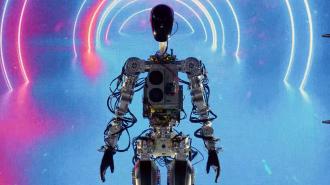CEO Elon Musk unveiled two prototypes of the Tesla robot at his company’s second annual AI Day — and while the bots are nowhere near as impressive as some of the humanoids we’ve seen before, they could have a bigger impact on the future of work.
The Tesla robot: In 2021, Tesla held its first AI Day, a livestreamed event to present its latest developments in AI hardware and software, with a focus on Tesla cars’ Autopilot system.
Near the end of the event, Tesla presented a short video of a sleek, humanoid robot — and then a person dressed like the robot walked onto the stage and broke into dance.
That bit of silliness was followed by Musk noting that, while the “robot” that preceded him on stage was obviously not real, the “Tesla bot” seen in the video would be.
“Tesla is arguably the world’s biggest robotics company because our cars are like semi-sentient robots on wheels … it kind of makes sense to put [Tesla’s tech] onto a humanoid form,” he said.
Musk added that the robot was intended to “eliminate dangerous, repetitive, and boring tasks” and said that Tesla would “probably have a prototype” in 2022.
What’s new? On September 30, 2022, Tesla held its second AI Day. This time, it started the event with a live demo of a “rough development” Tesla robot — named Bumble C and built using semi-off-the-shelf parts — gingerly walking, waving, and raising the roof.
“This is literally the first time the robot has operated without a tether,” said Musk, adding that “the robot can actually do a lot more than we just showed you — we just didn’t want it to fall on its face.”
Videos of a tethered Bumble C carrying boxes and watering plants in an office setting and moving metal bars at a factory station followed. Tesla then brought a prototype of an “Optimus robot” featuring fully-Tesla-designed actuators, battery packs, and control systems to the stage.
That Tesla robot waved and moved its limbs around while Musk noted its opposable thumbs and ability to move each of its fingers independently.
“It wasn’t quite ready to walk, but I think it will walk in a few weeks,” he said. “We wanted to show you … something that’s actually fairly close to what will go into production.”
The big picture: Anyone who has seen videos of robotics firm Boston Dynamics’ Atlas humanoid dominating obstacle courses or dancing the twist might feel more than a little underwhelmed by Optimus’ waves and flailing limbs — but they shouldn’t.
While Atlas is clearly more agile than either Tesla robot, it’s also designed to be a research platform, not a commercial product. That makes it impossible to know what each bot costs to build — the best context we have is Boston Dynamics’ much smaller robot dog Spot, which retails for $74,500.
“Our goal is to make a useful humanoid robot as quickly as possible.”
Elon Musk
Tesla’s goal is to sell its Optimus robot for less than $20,000 and produce millions of them, so it’s designing the bot with low costs and mass production in mind. Such a robot doesn’t need to be able to dance — it just needs to be able to do simple tasks, reliably.
“[Optimus production unit 1] is able to operate tools and do useful things,” said Musk during Tesla’s AI Day 2022. “Our goal is to make a useful humanoid robot as quickly as possible.”
When considering the Tesla robot’s current limitations, it’s also worth keeping in mind Musk’s stated “sole goal” for AI Day: convince the best AI talent to join the company.
So, yes, the Tesla robot doesn’t look awesome — yet. But if the AI Day demonstrations are enough to persuade top-level AI researchers to join Tesla, it could be awesome in the future.
We’d love to hear from you! If you have a comment about this article or if you have a tip for a future Freethink story, please email us at [email protected].






